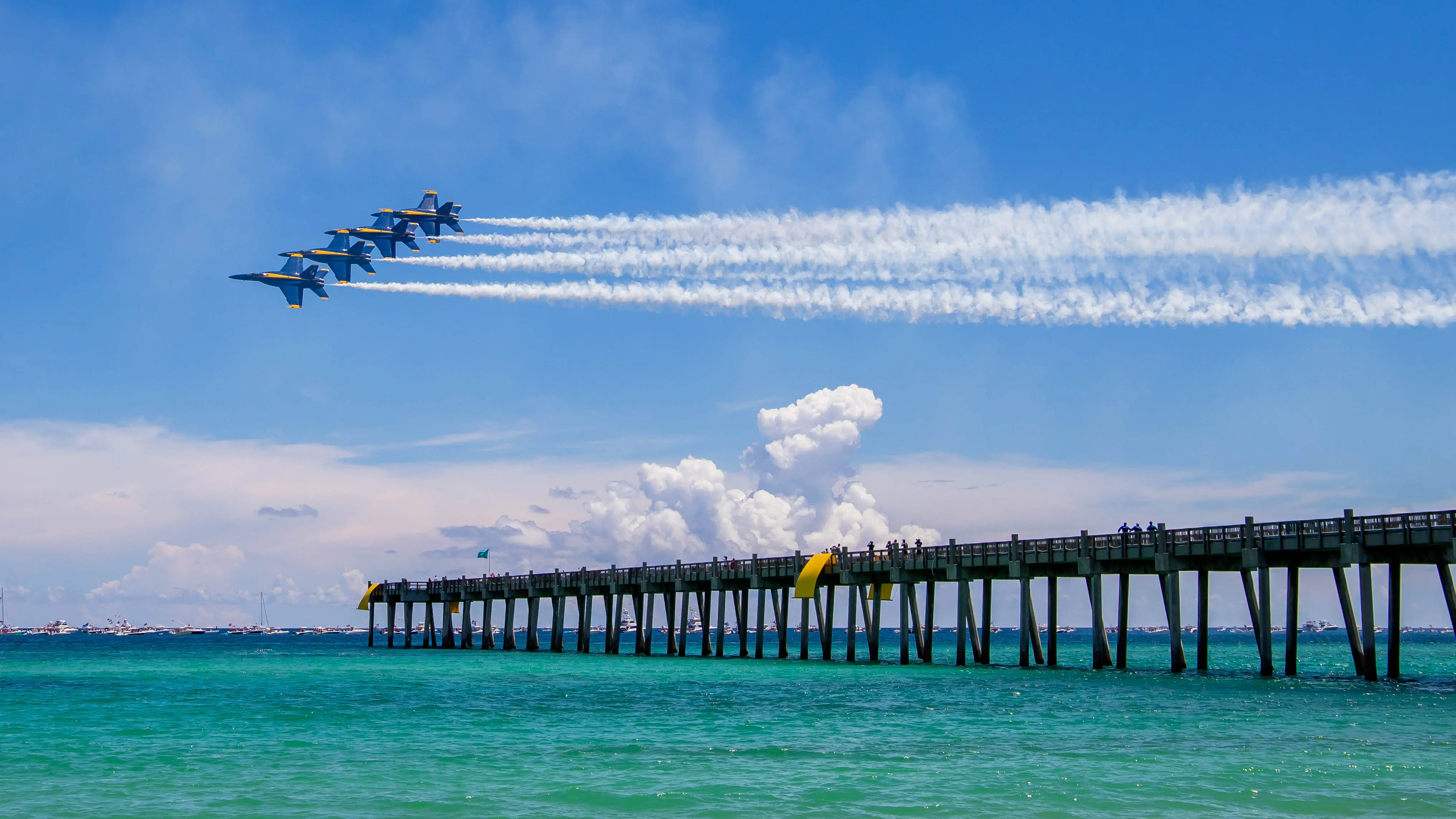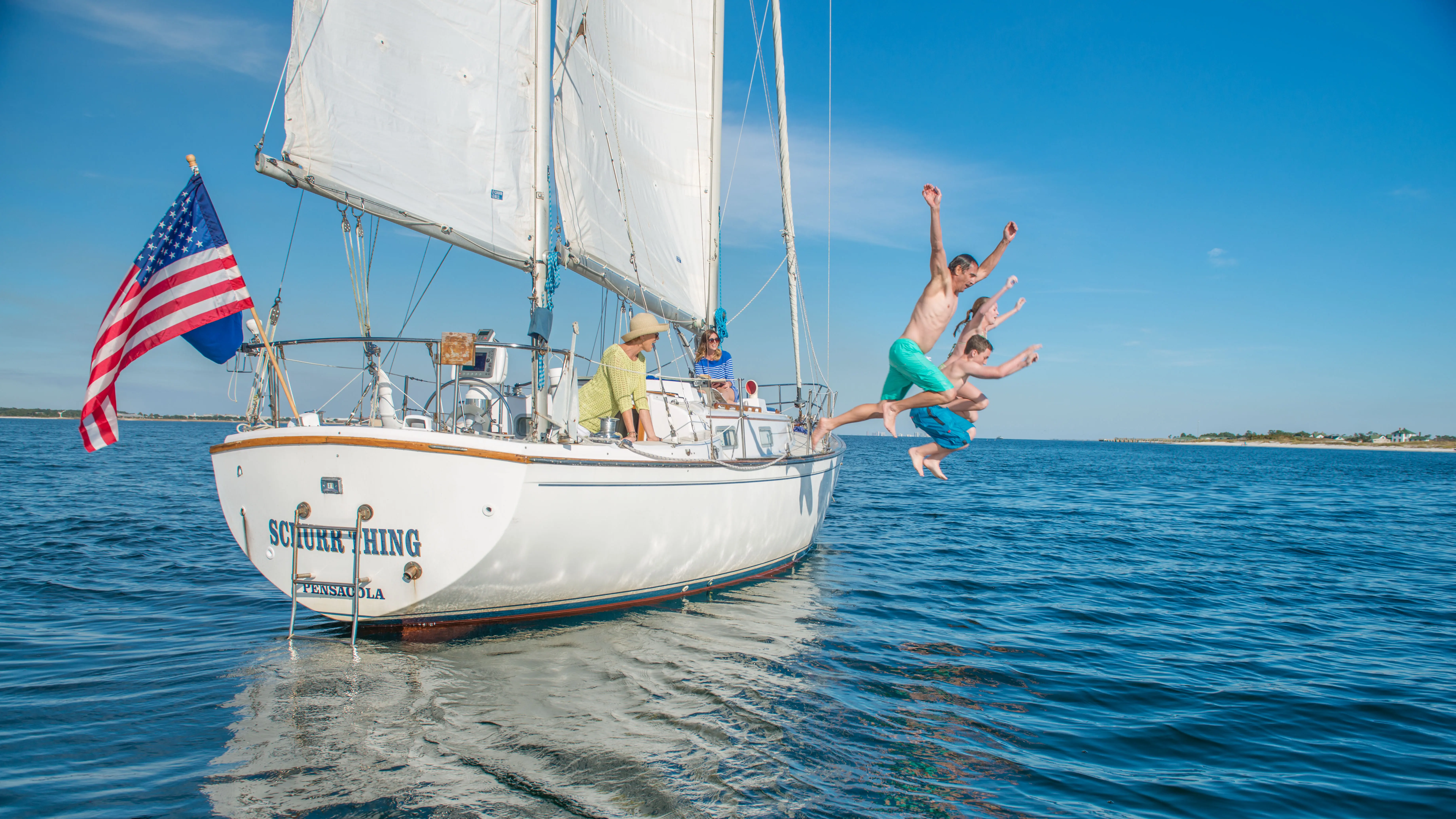Diving.

Have you always wanted to try scuba diving? Or are you seeking out new and exciting sites to explore?

Fly high and feel the roar of the U.S. Navy Blue Angels
Pensacola is lucky to be the home base for the U.S. Navy Blue Angels, the official flight demonstration team of the Navy. While they tour all over the country, we’re fortunate that they practice most Tuesdays and Wednesdays, March – November and host two shows a year, one on Pensacola Beach and one at NAS Pensacola.

Pedal your way to adventure
With popular trails like the Edward Ball Nature Trail and the Gulf Islands National Seashore, there are multiple places to bike for all levels. For the non-traditionalist, book an electric bike.
Good to Know
Diving in Northwest Florida offers a range of exciting underwater experiences, from wreck dives in the Gulf to the unique environment of a natural spring.
Here’s what you should know:
Visibility and Water Conditions
- Visibility: The water visibility in Northwest Florida can vary but is generally excellent, ranging from 30 to 100 feet in the Gulf of Mexico, particularly in summer months. Expect clearer water the further out you dive.
- Best Time to Dive: While diving is possible year-round, the best conditions are generally in late spring to early fall (April–September), when the water is warmer (ranging from 70°F to 80°F) and visibility is at its peak. Winter months can bring cooler water temperatures and less predictable conditions.
- Water Temperature: In winter, water temperatures can drop to 60°F (15°C), so a 5-7mm wetsuit may be necessary. During the warmer months, a thinner wetsuit or even a rash guard will suffice.
Marine Life
Northwest Florida is rich in marine biodiversity, and divers often encounter a variety of species, including:
- Reefs and Wrecks: Expect to see barracuda, grouper, snapper, amberjack, and sometimes larger pelagic species like tuna and sharks.
- Sharks: The region is home to several shark species, including sandbar sharks, bull sharks, and nurse sharks. Shark sightings are not unusual on deeper wreck dives.
- Turtles and Rays: Sea turtles (Loggerhead, Green, and Kemp's Ridley) are common, as are stingrays, manta rays, and eagle rays, particularly in deeper water.
- Fish Species: Along with the big fish, you can also see colorful schools of smaller fish like blue tangs, snapper, and wrasse.
Dive Operators and Certifications
- Northwest Florida Beaches has several dive shops and operators offering guided tours, equipment rentals, and certification courses (PADI, SSI, etc.).
- Ideal for kids 10+, many dive shops offer Discover Scuba classes where you can learn the basics, try on diving equipment and then try out your new skills in a shallow dive in the calm water.
- Some dive shops specialize in wreck diving or offer specific guided trips to unique dive sites.
- If you’re looking to dive the deeper wrecks or do technical dives, it’s essential to be an advanced or technical diver due to depth and visibility conditions.
Wreck Diving
- The expanded Florida Panhandle Shipwreck Trail offers something for every diver at all skill levels and depths, from beginner to PADI . The "choose your own adventure" series of dives offers an opportunity to explore all 20 vessels or focus areas that include all WWII era wrecks, tugboats, or specific regions (Pensacola, Panama City Beach, Destin-Fort Walton Beach).
Safety and Regulations
- Weather Conditions: Weather can change rapidly especially in the summer with thunderstorms. Always check the forecast before heading out, and be prepared for changing conditions.
- Dive Tables and Nitrox: Some dives, especially deeper wrecks, require careful planning with dive tables or dive computers. Nitrox (enriched air) can also be an option for reducing nitrogen absorption on deeper or longer dives.
- Marine Preservation: Always respect marine life and local environmental regulations. Many wrecks and reefs are part of artificial reef systems, and preserving these ecosystems is critical for sustainability.
- Currents: Currents can be strong, especially around deeper wrecks or when diving further offshore. Make sure to check tide and current reports.
- Deeper Dives: Many of the wrecks in the area are located at considerable depths (over 100 feet), so divers should be aware of the risks of decompression sickness. It's essential to be properly trained for deep dives and to use appropriate dive tables or computers.
- Navigation: The Gulf Coast has varying bottom topography, so divers may need to pay close attention to navigation, especially in areas with limited landmarks or strong currents.
Top Dive Sites in the Region
- Home to freshwater springs popular with swimmers, snorkelers, and divers of all levels, Sherlock Springs offers trained cave divers the chance to explore this natural wonder further.
- Sunk in 1942 by a German U-Boat torpedo, the HMS Empire Mica lies 21 miles south of Cape San Blas in 110 feet of water. Though mostly a rubble field, the boilers remain prominently at the center.
- Sunk under mysterious circumstances in 1942 while carrying lumber to Cuba, the SS Vamar is a great shallow water dive in 25 feet of water off the coast of Port St. Joe. Built in England as a patrol gunboat, the steamer boasts a large steam engine, bilge keels, and a wide variety of marine life.
- The Twin Tugs are a pair of surplus US Navy tugboats deployed in 2003. Originally positioned next to each other bow to bow, a strong storm actually lifted one of the tugs and placed it on the other making this a unique site to dive and explore to wrecks in one.
- The Underwater Museum of Art is the first permanent underwater sculpture garden in the country. Located off of Walton County, the museum lies at a depth of 58 feet and at a distance of .93-miles from the shore of Grayton Beach State Park. This site is home to nearly 50 artist created statues that can all be explored in a single dive.
- Deployed in 2023, the R/V MANTA is a former 180-foot oil research vessel that now offers ample swim-throughs for exploration. At 75 feet, the top deck features the 9-foot "Christ of the Gulf" statue, a highlight of this large artificial reef deployed approximately 16 nautical miles south of the coast of Destin-Fort Walton Beach.
- Located off the shores of Pensacola, the USS Oriskany is the world’s largest artificial reef. This sunken aircraft carrier offers unforgettable diving from 80 to 212 feet.
- One Mile Out Reef in Navarre Beach is made up of more than 550 modules that were deployed to create individual reef sites or patch reefs. This deepwater “nearshore” site is approximately 60 feet.
- Thanks to the Mexico Beach Artificial Reef Association in Gulf County you can experience over 200 reefs ranging in depths from 20 to 110 feet. A highlight is the SS Vamar - a 170-foot vessel that lies in about 25 feet of water and is included in Florida’s Underwater Archaeological Preserve.
Outfitters you can count on
Discover vibrant reefs and shipwrecks with expert local guides catering to all skill levels. Dive into adventure in Northwest Florida!
What people are
exploring
What is your adventure style?
your next great Northwest Florida adventure.

Count Me In
Stay up-to-date with all the latest and greatest that Northwest Florida Beaches has to offer.


